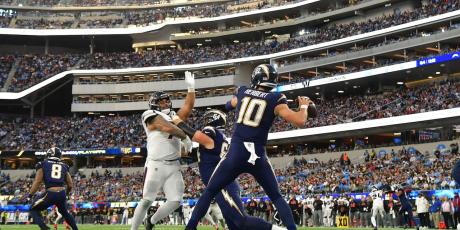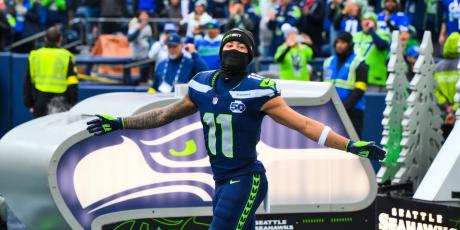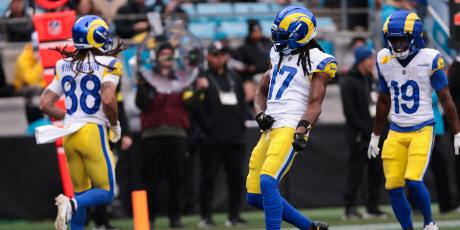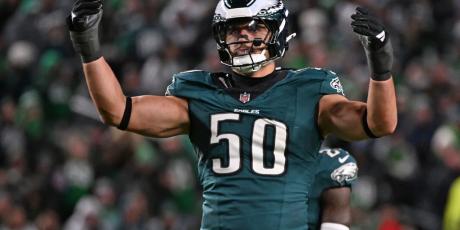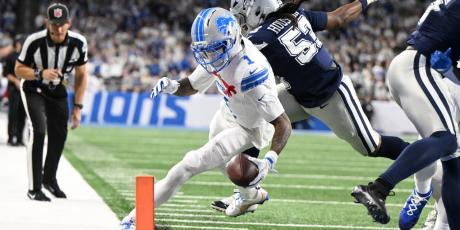A Look Back at Wide Receivers in 2018

Reviewing your own process in fantasy football is always a useful exercise but it’s also helpful to look at the previous season to see what trends you missed and what changed in the fantasy landscape. The following will examine what transpired at the wide receiver position in 2018.
Wide Receiver Draft Trends
Given the rise in popularity of draft strategies such as Zero RB, many fantasy drafters have taken to wide receivers instead of running backs in the first round, but the pendulum swung back to running backs in 2018.
| 2013 | 2014 | 2015 | 2016 | 2017 | 2018 | |
|---|---|---|---|---|---|---|
| WR1 | 6.9 | 6.1 | 5.2 | 2.0 | 4.6 | 5.7 |
| WR2 | 15.5 | 9.2 | 9.7 | 4.5 | 7.1 | 10.1 |
| WR3 | 15.6 | 12.5 | 10.4 | 5.0 | 8.2 | 11.3 |
| WR4 | 19.1 | 13.3 | 11.6 | 9.8 | 8.9 | 13.7 |
| WR5 | 20.5 | 16.2 | 12.0 | 11.4 | 11.9 | 17.3 |
| WR6 | 23.2 | 16.3 | 16.3 | 14.3 | 14.2 | 18.9 |
| WR7 | 27.3 | 22.2 | 19.5 | 16.4 | 16.8 | 19.0 |
| WR8 | 28.9 | 22.8 | 19.9 | 20.8 | 20.4 | 22.3 |
| WR9 | 30.9 | 24.8 | 24.4 | 21.9 | 22.4 | 26.2 |
| WR10 | 32.2 | 28.5 | 27.6 | 22.0 | 22.7 | 27.5 |
| WR11 | 35.0 | 35.0 | 28.8 | 22.3 | 28.0 | 32.3 |
| WR12 | 39.6 | 40.9 | 30.2 | 25.5 | 28.1 | 32.8 |
| WR13 | 40.2 | 41.0 | 33.4 | 27.4 | 31.3 | 38.5 |
| WR14 | 43.8 | 41.5 | 33.6 | 28.5 | 37.9 | 39.4 |
| WR15 | 45.4 | 42.0 | 34.6 | 30.8 | 38.6 | 39.4 |
| WR16 | 45.8 | 43.2 | 43.1 | 33.4 | 42.0 | 39.9 |
| WR17 | 46.5 | 46.2 | 44.1 | 35.5 | 43.9 | 44.4 |
| WR18 | 55.3 | 46.6 | 46.0 | 38.3 | 44.8 | 45.0 |
| WR19 | 55.9 | 51.0 | 46.7 | 41.2 | 46.2 | 45.5 |
| WR20 | 57.7 | 51.4 | 47.3 | 41.8 | 51.5 | 52.0 |
| WR21 | 58.3 | 55.2 | 49.0 | 45.2 | 51.8 | 52.6 |
| WR22 | 59.9 | 55.8 | 54.5 | 48.3 | 54.2 | 56.1 |
| WR23 | 60.9 | 58.3 | 55.6 | 52.0 | 57.2 | 56.4 |
| WR24 | 63.4 | 60.8 | 57.4 | 52.4 | 57.4 | 58.5 |
After three straight seasons with five receivers carrying a first-round ADP1, just three receivers were taken in the first round, on average, last year. With running backs making up seven of the top 10 non-quarterback PPR scores in 2017, it’s no surprise that owners went out of their way to try and lock up a top back last season.
Once the first six receivers went off the board, though, ADP at the position mostly fell back into place for players with a top-24 positional ADP.
With that, let’s take a look at how receivers fared compared to their price last year and how that stacks up to recent history.
Wide Receiver Return on Investment
The following table shows how wide receivers drafted as starters in 12-team leagues finished in PPR leagues last season2.
| Player | Team | Pos. ADP | Games | PPR Pts | PPR Pts/G | EOS Rank |
|---|---|---|---|---|---|---|
| Antonio Brown | PIT | 1 | 15 | 323.7 | 21.6 | 2 |
| DeAndre Hopkins | HOU | 2 | 15 | 306.8 | 20.5 | 4 |
| Odell Beckham | NYG | 3 | 12 | 230.3 | 19.2 | 14 |
| Julio Jones | ATL | 4 | 15 | 297.0 | 19.8 | 7 |
| Michael Thomas | NOS | 5 | 15 | 307.6 | 20.5 | 3 |
| Keenan Allen | LAC | 6 | 15 | 247.7 | 16.5 | 11 |
| Davante Adams | GBP | 7 | 15 | 327.6 | 21.8 | 1 |
| A.J. Green | CIN | 8 | 9 | 149.4 | 16.6 | 38 |
| Mike Evans | TBB | 9 | 15 | 255.8 | 17.1 | 10 |
| Tyreek Hill | KCC | 10 | 15 | 299.4 | 20.0 | 5 |
| Stefon Diggs | MIN | 11 | 14 | 245.6 | 17.5 | 12 |
| T.Y. Hilton | IND | 12 | 13 | 230.9 | 17.8 | 13 |
| Jarvis Landry | CLE | 13 | 15 | 193.9 | 12.9 | 21 |
| Larry Fitzgerald | ARI | 14 | 15 | 170.1 | 11.3 | 28 |
| Amari Cooper | DAL | 15 | 14 | 209.3 | 15.0 | 17 |
| Adam Thielen | MIN | 16 | 15 | 298.6 | 19.9 | 6 |
| JuJu Smith-Schuster | PIT | 17 | 15 | 280.2 | 18.7 | 8 |
| Brandin Cooks | LAR | 18 | 15 | 220.0 | 14.7 | 16 |
| Doug Baldwin | SEA | 19 | 12 | 137.1 | 11.4 | 45 |
| Allen Robinson | CHI | 20 | 13 | 153.3 | 11.8 | 35 |
| Demaryius Thomas | HOU | 21 | 15 | 156.7 | 10.4 | 33 |
| Marvin Jones | DET | 22 | 9 | 115.8 | 12.9 | 60 |
| Chris Hogan | NEP | 23 | 15 | 93.8 | 6.3 | 73 |
| Golden Tate | PHI | 24 | 14 | 173.6 | 12.4 | 26 |
On the whole, wide receiver was quite predictable in terms of who the top fantasy players would be. Exactly two-thirds of the receivers drafted in the top 24 at their position finished as such. In the five years prior, that hit rate was just under 61%. Furthermore, elite receivers continue to be extremely reliable fantasy assets—of the receivers drafted in the top 12 at their position, only A.J. Green finished outside the top 14 at their position in PPR leagues and Green was on pace with Keenan Allen who finished as the WR11. These results, however, aren’t typical. From 2013–2017, 28 of the 60 players drafted as WR1s finished as such and 32 finished in the top 14 at their position.
With some understanding of how the position has typically played out, and how 2018 stacked up against those trends, let’s take a look and which receivers overperformed in 2018 and who failed to live up to expectations, hopefully teasing out some lessons from the collective groups.
2018’s Most Undervalued Wide Receivers
| Player | Team | G | PPR Pts | PPR Pts/G | EOS Rank | Pos ADP |
|---|---|---|---|---|---|---|
| Tyler Boyd | CIN | 14 | 221.1 | 15.8 | 15 | 111 |
| Adam Humphries | TB | 15 | 177.1 | 11.8 | 24 | 105 |
| Tyler Lockett | SEA | 15 | 205.5 | 13.7 | 19 | 57 |
| Kenny Golladay | DET | 15 | 207.1 | 13.8 | 18 | 52 |
| Calvin Ridley | ATL | 15 | 192.6 | 12.8 | 22 | 48 |
Last year’s group of overperforming receivers can largely be explained by two major factors—a shakeup to the team’s depth chart or unsustainable efficiency. Let’s start with the former.
Tyler Boyd, Tyler Lockett and Kenny Golladay all started the season alongside receivers on their respective teams that were drafted as top 24 players at their position but missed a combined 15 games (excluding Week 17). In addition to benefiting from his teammate’s injury, Kenny Golladay also got a boost from a midseason trade involving Golden Tate to Philadelphia. Even before Boyd and Golladay were forced into WR1 roles, though, both flashed stand-alone fantasy value. Through eight weeks, A.J. Green had outscored Boyd by just 6.4 PPR points while Golladay was the overall WR16 through the first five games of the season.
While counting on injuries won’t net winning fantasy football results, there may be a counterintuitive lesson here. Rather than looking for fantasy’s next wide receiver breakout on a team that lacks a top threat, targeting receivers late in drafts that have some standalone value on a team that has proven capable of supporting a WR1 may sometimes be the shrewd move. In the event that an A.J. Green goes down, the owner of the next Tyler Boyd stands to benefit.
Although Lockett benefited from an injury-riddled Doug Baldwin, the Seahawks receiver saw his fantasy numbers buoyed by a monster touchdown rate, much like Calvin Ridley. Lockett and Ridley were two of three receivers (Emmanuel Sanders) to finish as top-24 PPR receivers with fewer than 100 targets—Lockett scored on 14.3% of his targets and Ridley on 10.9% of his. Over the last 10 seasons, there have been 650 instances of a wide receiver seeing at least 70 targets and only 20 have posted a touchdown rate above 10%. Going into any draft looking for these outliers is a fool’s errand.
Adam Humphries finished as a top-24 receiver but his season was largely a function of being involved in one of the most prolific fantasy passing games in the league—Tampa Bay ranked second in total quarterback fantasy points and produced four top-36 receivers through Week 16. Predicting the Buccaneer’s passing-game explosion was unlikely but it can be valuable to invest draft capital on ancillary pieces in productive passing games.
2018’s Most Overvalued Wide Receivers
| Player | Team | Pos ADP | Games | PPR Pts | PPR Pts/G | EOS Rank |
|---|---|---|---|---|---|---|
| Chris Hogan | NE | 23 | 15 | 93.8 | 6.3 | 73 |
| Marvin Jones | DET | 22 | 9 | 115.8 | 12.9 | 60 |
| A.J. Green | CIN | 8 | 9 | 149.4 | 16.6 | 38 |
| Doug Baldwin | SEA | 19 | 12 | 137.1 | 11.4 | 45 |
| Allen Robinson | CHI | 20 | 13 | 153.3 | 11.8 | 35 |
As discussed earlier, 2018 was one of the more predictable years in recent history for fantasy wide receivers, at least near the top. Those that did fall off were largely detracted by injuries, but a couple of players simply didn’t live up to expectations, namely Chris Hogan and Allen Robinson.
Drafters who targeted Hogan saw his 12.2 PPR point average in 2017 and extrapolated those totals to 2018 as part of what was expected to be a top passing attack. While the Patriots ranked 10th in passing yards, they were just 13th in passing touchdowns and Hogan fell victim to a deep depth chart with the second-most targeted running back in the league, a relatively healthy Rob Gronkowski who played 13 games, and a newly acquired Josh Gordon who maximized his 11-game stint.
Similarly, Robinson was a player who was expected to be the top receiver in an offense that many fantasy footballers were hoping would make a big leap in Mitch Trubisky’s second season with new head coach Matt Nagy. While Robinson was the top weapon in Chicago’s passing game, he saw just one more target than Taylor Gabriel and failed to eclipse 100 total targets. Meanwhile, the Bears finished in the bottom 10 in pass attempts and passing yards and just 14th in passing touchdowns.
Key Takeaways
The argument for wide receivers over running backs in the early rounds is consistency and predictability and in 2018 the wide receiver position got back to shining in PPR leagues, at least from a predictability standpoint. Still, the top-four non-quarterback scorers and five of the top-six were running backs last season, so expect running backs to again dominate the first round in 2019.
Especially in PPR leagues, though, this could prove a great value opportunity for owners drafting near the turn, opening up the option of landing two studs at a fairly reliable, high-volume position.
When looking for value later in drafts, it could be savvy to target number two receivers with some stand-alone value, even if they are playing across from an alpha number one, especially in a prolific passing game. Too often, drafters get tunnel vision for a player that might be his team’s number one, but only by name, which often results in middling fantasy results.
1. ADP data is for August drafts from MyFantasyLeague.com
2. End-of-season fantasy points for Weeks 1–16 from the 4for4 Fantasy Points Browser







